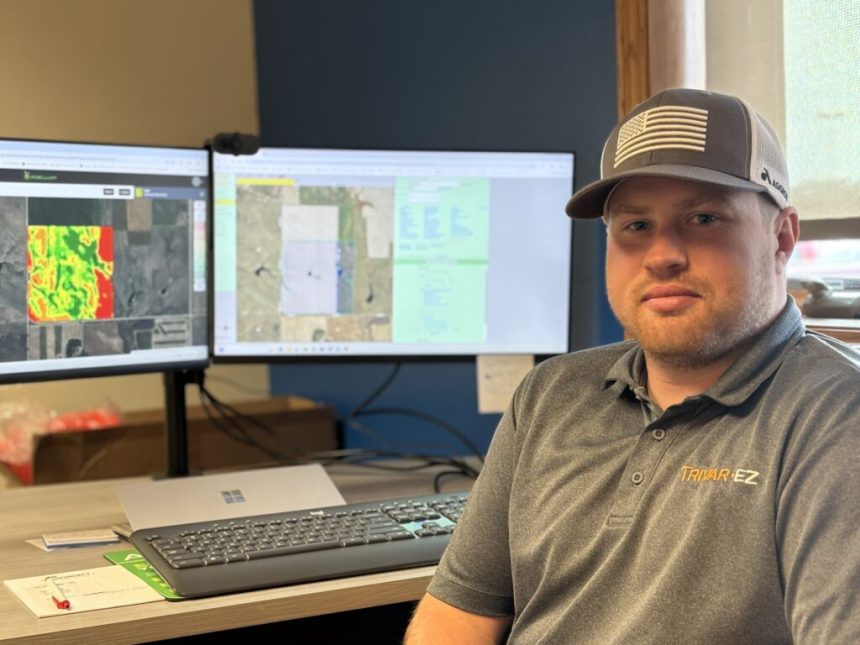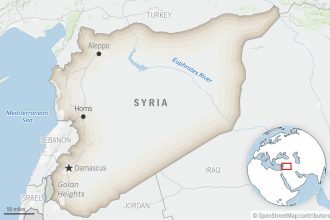Cody Kafka sits at his work desk in Mitchell with his new land purchase displayed on his computer screen on Sept. 4, 2025. (Joshua Haiar/South Dakota Searchlight)
MITCHELL — Cody Kafka had dreamed of farming his own land since he began working on a farm in his teens, but that seemed unlikely without land to inherit. So it felt good when he finally walked across his own acres for the first time this year.
“It was one of the most freeing feelings I’ve ever really felt,” Kafka said.
He owed the feeling to a little-known program administered by the state.
Kafka and his wife, Codi, who live in Alexandria, started thinking seriously about getting into farming last year. But finding a lender was difficult until the Kafkas came across South Dakota’s Beginning Farmer Bond Program.
“Without this program, I don’t think it would have been possible,” Kafka said.
Kafka, an ag products salesman in Mitchell, and his wife, an accountant, were approved this year for the program along with one other applicant.
The program facilitates the sale of bonds to purchasers who receive federally tax-exempt interest, enabling loans to first-generation farmers at low interest rates. The program helps new farmers acquire land, equipment or livestock. Awardees must farm the land, not just own it.
Board members affiliated with the Governor’s Office of Economic Development, which administers the program, approved a total of $4.6 million in bonds for 13 applicants statewide from 2019 to this year, an average of about $354,000 per award. The office said it has received no reports of awardees not paying off loans on time.
High land and equipment costs mean aspiring farmers face limited access to credit, and modern farming methods have allowed fewer farmers to farm more land.
U.S. Department of Agriculture reports show the number of farms in the state dropped from 34,000 in 1994 to 28,300 in 2024. The sharpest declines occurred among medium-sized farms. Large-scale farms operating on 2,000 acres or more now control over two-thirds of the cropland in the state, according to a South Dakota State University report. Thirty years ago, large farms controlled less than half of the state’s cropland.
And those aren’t the only challenges facing new farmers.
“Commodity prices fluctuating, droughts, excessive rain, etcetera,” Kafka said. “It really is a risky business, and so it was very, very nerve-racking to take a big financial step such as this.”
The Kafkas received $510,000 to purchase 160 acres near Gregory. This spring, Cody Kafka planted corn.
For Bill Even, commissioner of the Governor’s Office of Economic Development, overseeing the program is personally gratifying. When he was a young, “asset-poor farmer,” he said, a U.S. Department of Agriculture farmer loan program “allowed me the chance to buy my first piece of farm ground.”
Even said that without that program’s low-interest rate, plus his own equity and a commercial lender, he wouldn’t have been able to get established.
Kafka said he was turned down for a USDA farmer loan because he did not have the required farm income history. That’s when he came across the state-administered program online.
“It’s still stringent — you need balance sheets, cash flows, all of that,” he said. “But they want people exactly like us, with little experience but stable finances, to get a chance.”
Kafka said he is working to improve the soil health of his new land, and experimenting with cover crops, rotational grazing and regenerative practices.
The math is tough this year. Corn prices are down nearly a dollar per bushel from what the Kafkas budgeted.
“We’re penciling in a loss,” Kafka said.
But they view the land as a long-term investment. With off-farm income to cushion their losses, he hopes to weather the early years.
“Land hasn’t depreciated since the 1980s,” he said. “That, and it’ll be paid for in 20 years. And, hopefully, I’ll live another 20 after that.”
-
6:22 pmThis story has been updated with a correction. The original version incorrectly described Cody Kafka’s job.








